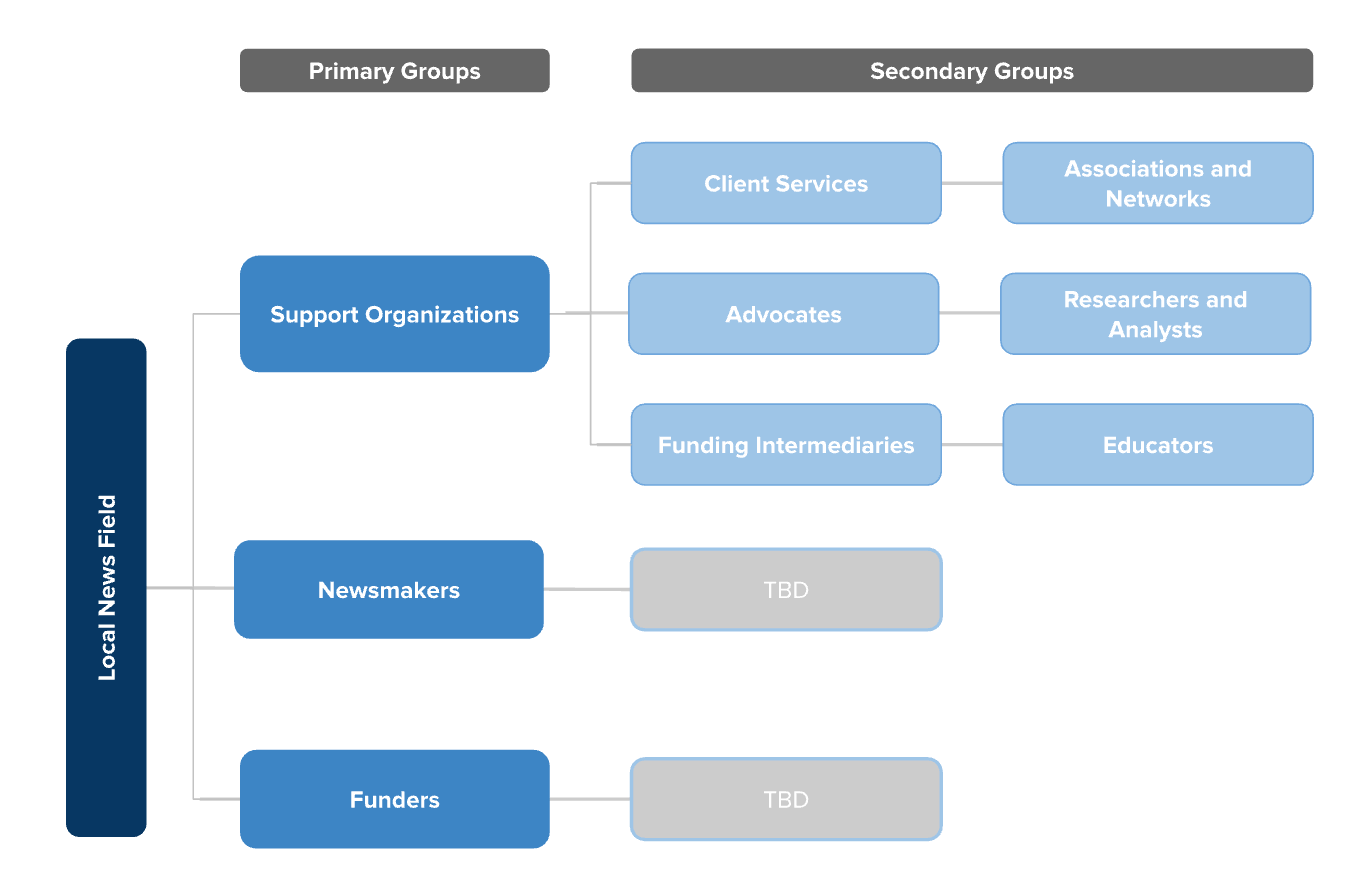Looking deeper at the role of journalism support orgs
Report finds a need for best practices, metrics for success and input from funders

Imagine you are a consultant for a local news publisher, and employees ask you where they can go for support. “Well, for associations, you can try LION Publishers, Institute for Nonprofit News (INN) or Local Media Association (LMA). For revenues, there’s News Revenue Hub, Newspack or BlueLena…” And the list goes on.
It might be the best of times for journalism support organizations (JSOs) because there are more of them doing the important work of supporting local news at scale—and newsrooms need help on so many fronts. But there also has been criticism that JSOs have taken more than their share of funding, and that their missions often overlap. So it’s great to see a report from Commoner Co—funded by Democracy Fund—that aims to make sense of the growing number of JSOs.
According to the report, what’s needed is “a field-level agenda as a plan that brings an expansive but representative cohort of the field together to define common goals within a collaborative rubric.” The problem is that there are not a lot of shared metrics for success across JSOs. The full report came up with some recommendations:
Codify best practices and instruments for assessing community information needs.
Make support organizations’ offerings more accessible and navigable while streamlining, consolidating and strengthening those offerings.
Engage in public policy development to generate public funding for newsmakers and shift the narrative on the value of local news.
Draw on knowledge from outside the local news field to attract and develop existing talent and leadership who can strengthen business practices.
While the report focused on those leading JSOs, it acknowledged the need for input from newsrooms and funders in future reports. INN’s Karen Rundlet (a former Knight program officer) asked, “How might funders better determine which programs/projects to sunset and which to stick with for decades?”
The report gives the field a lot to consider, including how to encourage more JSOs to collaborate so that their initiatives don’t overlap and newsrooms are better able to find the right JSOs at the right time.
Knight believes strongly in the mission of these support organizations to make the field of local news stronger and more sustainable, and we’ve seen evidence that publisher engagement with JSOs is good for the bottom lines of newsrooms. From INN’s Rural News Network to Knight x LMA BloomLab to LION’s Sustainability Audits and many other interventions, there are now programs available for publishers of all shapes and sizes.
It’s now time to help JSOs become more efficient and collaborative so they can be even more effective weapons in the battle to save local news. Knight will be active on this front in 2025, and we welcome ideas and proposals based on the report’s timely recommendations.
Other news around the horn…
Investments
🚀 NEWSWELL launches with $5 million from Knight. We’ve seen a growing number of partnerships between universities and local news outlets, but a new initiative out of Arizona State University called NEWSWELL takes this type of partnership to the next level. The school officially launched the nonprofit last month with a $5 million investment from Knight, and aims to take donated news outlets and transform them into sustainable businesses by providing operational support. As NEWSWELL Executive Director Nicole Carroll—the former editor-in-chief of USA Today—explained in Poynter, NEWSWELL will take news outlets and provide assistance with finance, IT, human resources and legal services, along with expertise in audience development, membership and advertising. How? With a team of experts offering advice, ASU Enterprise Partners handling the back end and the Walter Cronkite School of Journalism and Mass Communication providing student interns. “While no student funds go to these news sites, NEWSWELL editors act as master teachers to Cronkite interns, giving our students a jumpstart on their careers and our newsrooms an unmatched talent pipeline,” Carroll wrote.
💡 MacArthur unveils local news strategy, $6 million for climate journalism. MacArthur Foundation has gone all-in supporting local news, leading the creation of Press Forward and making local news one of its “Big Bets.” Now it’s outlining its strategy for local news, and has its own four pillars: equity (see graphic above), engagement, infrastructure and visibility. As Silvia Rivera, MacArthur’s director of local news, points out, the foundation has already invested $90 million in local news and should surpass its $150 million commitment by 2028. “We believe we are uniquely positioned to support initiatives that actively uplift underrepresented voices and direct resources where they are most needed and can have the greatest impact,” Rivera wrote. MacArthur put its strategy into action with a $6 million investment in climate journalism, making $300,000 to $500,000 three-year grants to 15 climate-related newsrooms and organizations. The goal is to strengthen investigative journalism, educate the public and stakeholders, promote accountability and bring in more peer funders to the field.
Impact
🔍 California newsrooms debunk ICE rumors, provide resources. As the Trump Administration ramps up deportations of undocumented immigrants, rumors are swirling about ICE agents all over the country. In Kern County, Calif., Border Patrol raids took place in January; many small nonprofit newsrooms have stepped in to counter misinformation and provide resource guides for folks in the community, the Guardian reports. Fresnoland provided a detailed account of the Kern County raids, including a list of resources and rights for immigrants. Mission Local in San Francisco provided another guide to what immigrants should know, and El Timpano has provided disinformation defense workshops. “Even news organizations can get duped,” said Alma Martinez, executive director of the Central Valley Journalism Collaborative. “We have to lead by example and make sure we’re providing news that is truthful, that’s objective, and that gets to the heart of what is happening.”
Research
🌿 Homegrown Ads: Challenges, solutions for small publishers selling ads. Small and startup publishers face a lot of hurdles when starting an ad program, including figuring out the technology, training sales staff and connecting with local businesses. But a recent study from Tiny News Collective and Rebuild Local News, funded by the William and Flora Hewlett Foundation, also outlined some opportunities for smaller publishers to create ad programs that fit their missions. The study found that organizational readiness is a hurdle, articulating a unique value proposition is key and founder-led sales are both a challenge (due to limited capacity) and an opportunity (they can best tell the publication’s story). Some tips for publishers include: start small, don’t overcomplicate it, offer multi-platform packages, and create a “Reader’s Choice Awards” contest. The report’s authors will present a webinar on Feb. 25 to provide tips for small publishers that are building ad programs.
📈 Blue Engine shares tips for geographic expansion. For pollinating news deserts, there’s the “build it” or “expand it” routes for local newsrooms, either starting a new newsroom or expanding from a nearby locale. That latter route is starting to gain momentum thanks to American Journalism Project’s investments last October in Virginia, Colorado and Utah, and the new Knight Growth Challenge Fund. For other newsrooms considering a geographic expansion, Blue Engine Collaborative’s David Grant laid out some tips based on his work with publishers in the Growth Challenge Fund. He says that newsrooms should do the research, but “don’t get stuck in it” trying to create a perfect market analysis. Grant also says to build a local coalition of supporters who can help you understand your new community and might even provide early funding. Most importantly, you need to build a financial model that considers hiring journalists, salespeople and a publisher, planning a marketing budget, and finding potential revenue sources. Want to see Blue Engine’s templates for mapping out an expansion? Hit Grant up at david@blueenginecollaborative.com.
⛰️ Montana map shows factors that lead to news deserts. A recent local news map created by LOR Foundation is exceptional not just because it maps news outlets and creators in the state. The map’s layers show factors such as population, college education, non-white population and homes with broadband. LOR found that counties with larger populations, higher incomes, more private businesses, higher education and younger populations typically had more local news outlets. So what are the next steps to help fill the gaps? “Locals might use this report as a call to action among their peers to support the local outlets they love—or be inspired to start their own,” the report concludes. “While starting a news site seems like a daunting task, this inventory found innovative entrepreneurs that are already doing it, and there are organizations (such as Tiny News Collective) out there that can help.”
Call-out
The GAIN 2025 Challenge: Generative AI in the Newsroom is looking for use cases for generative AI and how those use cases are evaluated. If you work with generative AI in news production, send along details about your organizational context and use case, evaluation approach, learnings and ongoing challenges. Those invited to write up their approach for the blog will be paid $500 for their time and effort in contributing upon acceptance of the final draft. Learn more and apply by the end of March.
Jobs
VT Digger, Editor-in-Chief
Learn more here.
University of Florida, Professor/Knight Chair in Journalism and Technology
Learn more here.
Buckeye Flame, Development Director
Learn more here.
Report for America, Director of Brand Strategy and additional positions
Learn more here.
Los Angeles Local News Initiative, Executive Editor and additional positions
Learn more here.
The Signal Network, Legal & Support Manager
Learn more here.
Mercer University, Journalism & Media Studies, Assistant Professor of Practice
Learn more here.
Training
Nonprofit News Business Certificate
9-month hybrid business training for nonprofit news leaders
Newmark Graduate School of Journalism at CUNY
Full scholarships thanks to Knight funding
Apply by March 3
Upcoming Events 📅
Miami
February 18–20
Nationwide
February 27
March 6–9
Minneapolis
International Symposium for Online Journalism (ISOJ)
Austin
March 27–28
International Journalism Festival
Perugia, Italy
April 9–13
Hacks/Hackers AI x Journalism Summit
Baltimore
May 7–8
Collaborative Journalism Summit
Denver
May 15–16
Lenfest News Philanthropy Summit
Philadelphia
May 20–22
Minneapolis
June 3–5
Philadelphia
June 10
Radio Television Digital News Association
New Orleans
June 11–13
Investigative Reporters & Editors
New Orleans
June 19–22
Quote of the Week
“People across [Tulsa] were lacking things that they felt that they needed in a news publication. They didn’t see reflections of themselves enough. They didn’t see enough good news. They did not see enough critical analysis of public officials…We’re using those ideas to create the vision for the new nonprofit publication, a daily digital publication that will be serving readers across the city.”
—Gary Lee, executive editor, Tulsa Local News Initiative and Oklahoma Eagle, discussing the $14 million invested in Tulsa local news in a Nieman Lab story
News @ Knight Credits
Written by Jim Brady, with Mark Glaser
Edited by Jim Brady and Kara Pickman






